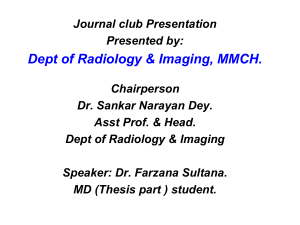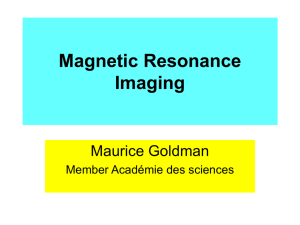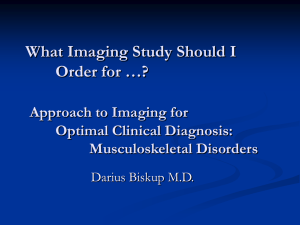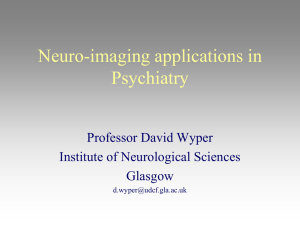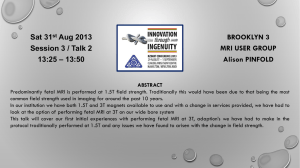Speaker Name - X-CD System Conference Management
advertisement
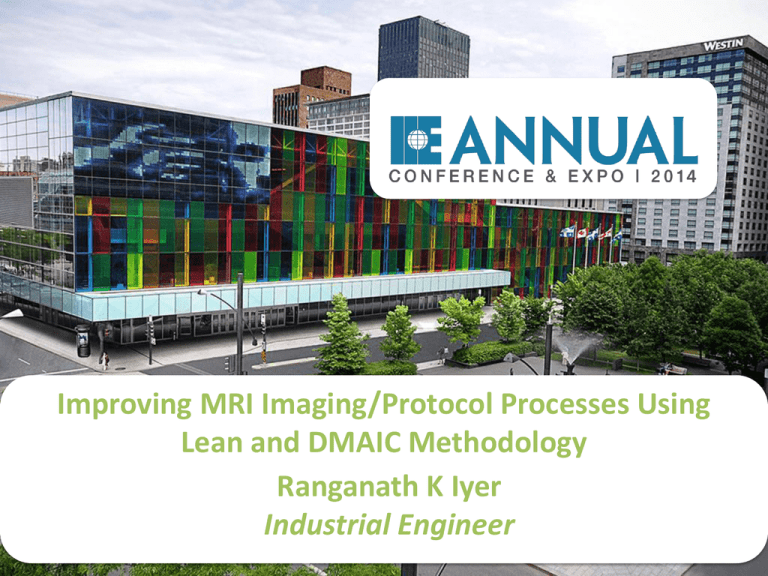
Improving MRI Imaging/Protocol Processes Using Lean and DMAIC Methodology Ranganath K Iyer Industrial Engineer TEAM INFO Sponsor: Dr. Joseph Steele Champion: Dr. Eric Paulson Team Members: − − − − − Habib Tannir Aziz Benamar Mary A. Cuellar Jim Thomas Ranganath Iyer, Facilitator Visitors − − − − Dr. Janio Szklaruk Nancy Swanston Victor Arboleda Steve Venable Strategic Priority: Enhance the quality and value of our patient care. Abstract MD Anderson's enhanced reputation for quality imaging studies is helping its MRI volume grow at an annual rate of 3%. This growth has placed the scanners close to capacity, and it is difficult to absorb new patients. The study describes how MRI imaging protocols and processes were improved using Lean tools, thereby reducing overall procedure time. Also, image quality was optimized, resulting in an enhanced guide to treating patients. To improve processes and enhance quality is aligned not only with MD Anderson’s goal but also with the Institute of Medicine’s goal of redesigning care delivery. Aims The purpose of the study was to rethink MRI processes and protocols in a new and dynamic way to reduce overall procedure time so additional patients can be added to the schedule. Also, image quality was optimized, resulting in an enhanced guide to treating patients. Methods The study team used Lean tools to generate and implement 31 new ways to either build or rebuild current MRI processes. Examples include developing new schedules and pre-screening patients for implants and anxiety. In addition, DMAIC provided the framework for carrying out the study in a systematic manner. Tools included: Process Flow Diagram, Fishbone Diagram, Voice of Customer, Control Charts, etc. Owing to the large volume of abdomen and/or pelvis procedures , the study team decided to target these procedures for improvement. Scan time, table time, and acquisition time were used as the metrics. Learning Objectives • Application of Lean tools in improving imaging/protocol processes. • Understanding how best practices in the PET area were used to develop process and quality improvement solutions in MRI. • Understanding how “image sequences“ which are building blocks of a protocol can be standardized. • What to do (statistically) if bimodal data shows up in your analysis • How the “Control” phase in DMAIC methodology played a role in sustaining the improvement process. Background Some process improvement in performing MRI studies has been undertaken in the past two years but has not involved reviewing activities at the protocol level. The sequences are the core building blocks of any protocol. Without examining this buildup, the selection of a single protocol for abdominal MRI, to require protocol prescription 24 hours in advance, and guidelines for contrast agent selection, cannot be administered consistently. The reason, an examination of the sequence has not been performed previously is that although both table time and machine time have been captured in a GE database in real time, this information has been unavailable for analysis by end-users owing to proprietary issues and HIPPA compliancy. GE, one of the two MRI vendors, was very helpful and created a customized HIPPA-compliant report with meaningful information for protocol analysis. Application of Lean tools in improving imaging/protocol processes. Table A Literature states eight types • Transportation • Overproduction • Inventory • Over-processing of waste (MUDA), shown in • Motion • Defects Table A. • Waiting • Standards Lacking A fishbone diagram indicated the following as the main causes of waste in the MRI department: • Technicians with different levels of training • Restricted scheduling of slots • Customized protocoling for each patient • Handoffs from technicians to radiologists. • Standardized work Cause and Effect Diagram Improve Process One quality tool that was used extensively was the “Voice of Customer” tool to gather customer requirements at all stages of the study. Process Flow Diagram Microsoft Visio was used to process and diagram the steps needed for lab and protocol-approval processes. The analysis indicated that the work process included many delays and calls to radiologists. Baseline Metrics Baseline metrics for scan time, table time, and acquisition time were established using calendar year 2012 data. The Minitab software package was used to calculate statistics. The table summarizes January 2012 through December 2012 data for scan time (RIS), table time (GE), and acquisition time (GE). These data provided us with targeted goals to achieve at the end of the study. Understanding how best practices in the PET area were used to develop process and quality improvement solutions in MRI. MD Anderson is a large institution, and imaging modalities (PET, MRI, CT, NM, etc.) are housed in different buildings and locations. Thus, we were able to use other imaging modalities’ experience as a benchmark for the study. Some best practices were borrowed from the PET area, where these solutions had successfully worked in the past. The study team brainstormed solutions to generate 32 new ways to either build or rebuild current MRI processes for improvement. Solutions included modifications in the current practice of radiologists, technologists, and nurses. Among these, the most effective and farreaching were the selection of a single protocol for abdominal MRI, a required protocol prescription 24 hours in advance of imaging, and guidelines for contrast agent selection. Some of the other interventions were: Develop a new schedule to optimize MRI slots based on time data Preview patients for all slots Enforce the anxiety policy and educate patients on pre-meds Educate technicians to standardize the RIS entry tracking process Pre-screening every patient 1-2 days out for implant clarifications Enforce policy and educate patients on “HARD STICKS” Understanding how “image sequences," which are the core building blocks of a protocol can be standardized. Analysis of data from February 2012 to December 2012 indicated that combined MRI of the abdomen with or without contrast and pelvis with or without contrast represented 21% of the total volume of the top 10 MRI procedures. Also, senior leadership including the chair of diagnostic imaging were interested in making improvements in this area. Some of the sequences used to build MRI ABD with or without contrast are shown in the table on the next slide. Sequences described in the “Series description” column varied from patient to patient and from radiologist to radiologist. The abdominal section radiologists standardized the exam and published one protocol. Exceptions or additional sequences were added owing to patients’ conditions and were noted in the patients’ charts. The metrics average exam time, average machine time, and number of sequences per procedure were used to monitor improvements and compliance with the requested changes. What to do (statistically) if bimodal data shows up in your analysis Statistical analysis was done to assess the acquisition time data for MRI ABD with or without contrast procedure. The analysis indicated that the data were bimodal, which indicated that the data contained two different clusters or protocols. TIMEPERIOD = Jan-Dec 2012 Anderson-Darling Normality Test A-Squared P-Value < Mean StDev Variance Skewness Kurtosis N 0 30 60 90 120 150 Minimum 1st Quartile Median 3rd Quartile Maximum 180 70.64 0.005 48.930 23.081 532.743 0.842530 0.729621 2675 1.250 32.020 41.260 66.600 195.260 95% Confidence Interval for Mean 95% Confidence Intervals 48.055 49.805 95% Confidence Interval for Median Mean 40.203 42.120 95% Confidence Interval for StDev Median 40 42 44 46 48 50 22.479 23.717 ABD with or without contrast procedure with different protocols embedded in the data Mean Time ~ 49 minutes If details are not available, then cluster analysis could be used to calculate the means. However, in our example, we did a more detailed analysis by separating the protocols in the data and then calculating the means. Summary for AcquisitionTime Anderson-Darling Normality Test A-Squared P-Value < 0 20 40 60 80 100 13.79 0.005 Mean StDev Variance Skewness Kurtosis N 36.876 10.156 103.148 0.22640 4.80707 983 Minimum 1st Quartile Median 3rd Quartile Maximum 1.000 32.000 36.000 42.000 109.000 95% Confidence Interval for Mean 36.240 37.512 95% Confidence Interval for Median 36.000 95% Confidence Intervals 9.726 Mean Median 36.00 36.25 36.50 36.75 37.00 37.000 95% Confidence Interval for StDev 37.25 37.50 10.626 Mean Time ~ 37 minutes ABD with or without contrast procedure with ABD protocol only How the “Control” phase in DMAIC methodology played a role in sustaining the improvement process. Control charts were used on a monthly basis to monitor the reduction in scan time, table time, and acquisition time. If the control charts showed an upward trend, we reviewed the sequences to see if the radiologist’s or technician’s practice pattern changed. Results Overall scan time was reduced by 10%. Conclusions Findings suggest that the team achieved a 10% decrease in overall MRI scan time. Lessons learned include: -Incremental process changes can result in large savings. -Statistical tools are great investigative tools for large data sets. An imaging procedure could contain as many as 32 sequences. -Lean methodology and DMAIC framework yielded a successful study. Bio’s Ranganath K Iyer Ranganath K Iyer is a certified six sigma black belt and an Industrial Engineer at MD Anderson Cancer Center. He brings with him over 30 plus years of Industrial Engineering experience in managing and facilitating cross functional project teams at major health care institution. His work experience in healthcare is complimented with a Master's degree in Industrial Engineering. Also, he has presented at various conferences including Institute of Industrial Engineers (IIE), American Society for Quality (ASQ), and Society for Health Systems (SHS). He is a Senior Member for IIE and ASQ Habib Tannir Habib Tannir is the Executive Director of Clinical Operations at MD Anderson Cancer Center in Houston Texas. He's been in that role for one year. For seven years before that, he served as Associate Hospital Administrator at Emory Healthcare and Department Administrator of Emory University School of Medicine Department of Radiology and Imaging Sciences. He also held positions at University Community Health in Tampa, General Electric Medical Systems, and William Beaumont Hospital in Royal Oak Michigan. He is a biomedical engineer by formal education and has been in the healthcare industry since 1995. Bio’s Dr. Szklaruk Janio Dr. Szklaruk Janio is a Professor of Diagnostic Imaging at The University of Texas MD Anderson Cancer Center, where he has been a faculty member for the last thirteen years. Previously, he was an Assistant Professor in the Radiology Department at Hahnemann University Hospital in Philadelphia, and have been a Visiting Professor at several institutions. His focus is the application of computed tomography and magnetic resonance imaging in the evaluation of hepatobiliary tumors. He has over 45 publications, multiple abstracts, multiple book chapters, and numerous presentations at multiple national and international meetings. He has trained and mentored residents, fellows and junior staff at The University of Texas MD Anderson Cancer Center. He completed a radiology residency in Diagnostic Imaging at Thomas Jefferson University Hospital. Bio’s Steve Venable Steve Venable has been at M.D. Anderson Cancer Center since 1995. He has held various administrative positions and is now the Director of Diagnostic Imaging Strategic Operations. Mr. Venable was the project coordinator for a Six Sigma Project in Computed Tomography, the first Six Sigma endeavor at MDACC with a focus on increased capacity. Since that time Mr. Venable has been a leading proponent in leveraging data sources and information systems to understand and improve clinical efficiency, safety and project future needs and has successfully imbedded Industrial Engineers within Diagnostic Imaging. Bio’s Aziz Benamar In his most recent role, Aziz is a Director of Clinical Operation in the Division of Diagnostic Imaging at MD Anderson Cancer Center where he is responsible for the operations of nine imaging modalities including Magnetic Resonance Imaging, Computer Tomography and Nuclear Medicine. His work experience of over 21 years includes Houston Northwest Medical Center and Memorial Hermann Healthcare System , progressing moving from the position of Radiology Technologist to Imaging Services Manager and to Director of Imaging Services. He believes strongly in mentoring and empowering staff and interdisciplinary team members to provide safe, high quality, cost effective and customer service oriented patient care. Aziz received his Bachelor of Science in Radiology Technology from Mid-Western State University and his Master of Business Administration in 2008.




